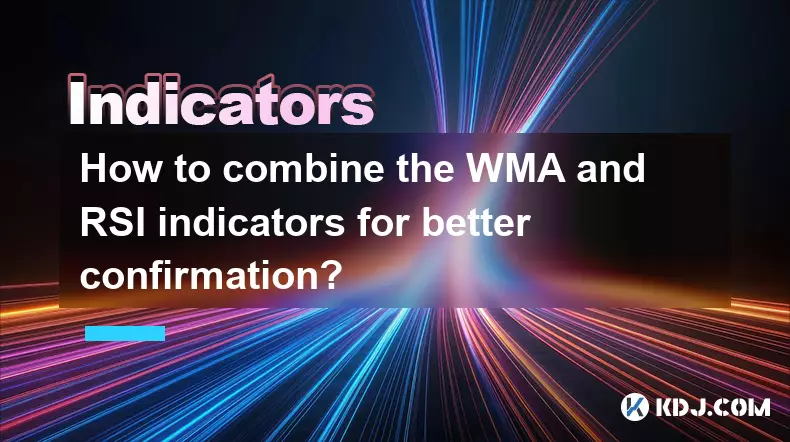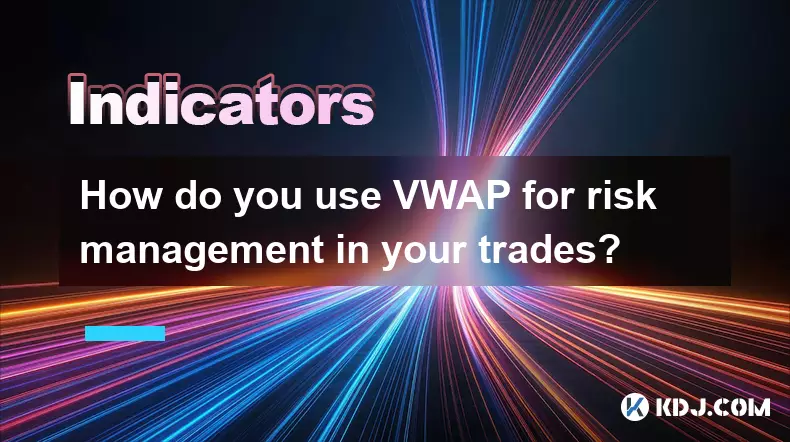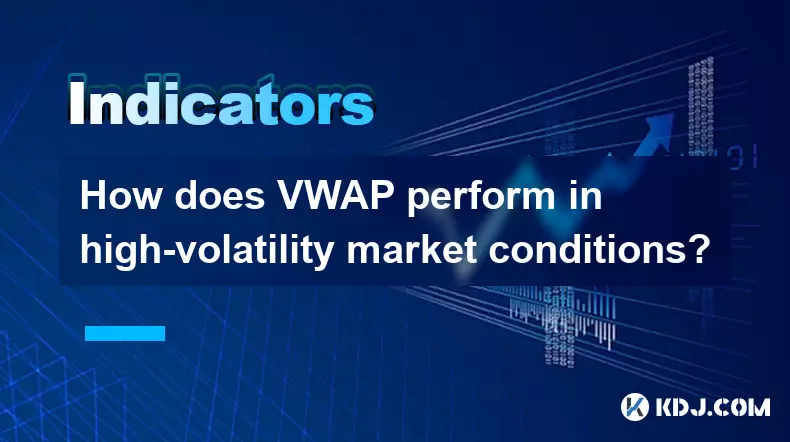-
 bitcoin
bitcoin $115692.075601 USD
5.13% -
 ethereum
ethereum $4162.931611 USD
11.68% -
 bnb
bnb $1310.063287 USD
17.56% -
 tether
tether $1.000983 USD
0.00% -
 xrp
xrp $2.534505 USD
8.16% -
 solana
solana $198.235737 USD
13.49% -
 usd-coin
usd-coin $1.000236 USD
0.02% -
 dogecoin
dogecoin $0.207352 USD
12.89% -
 tron
tron $0.323043 USD
3.62% -
 cardano
cardano $0.701559 USD
11.88% -
 hyperliquid
hyperliquid $39.924597 USD
8.30% -
 chainlink
chainlink $18.934457 USD
11.56% -
 ethena-usde
ethena-usde $1.000552 USD
0.02% -
 stellar
stellar $0.340575 USD
7.05% -
 bitcoin-cash
bitcoin-cash $545.011757 USD
8.86%
How to combine the WMA and RSI indicators for better confirmation?
Combining WMA and RSI enhances trading accuracy by aligning trend direction with momentum, reducing false signals in volatile crypto markets.
Oct 13, 2025 at 02:36 am

Understanding the WMA and RSI Indicators
1. The Weighted Moving Average (WMA) assigns greater importance to recent price data, making it more responsive to new information compared to simple moving averages. This sensitivity allows traders to detect trend shifts earlier, especially in fast-moving crypto markets where delays can mean missed opportunities.
2. The Relative Strength Index (RSI) measures the speed and change of price movements on a scale from 0 to 100, commonly used to identify overbought or oversold conditions. In the volatile environment of cryptocurrency trading, RSI helps filter false breakouts by highlighting momentum extremes.
3. When combined, these two indicators offer both directional bias through WMA and momentum context via RSI. Their synergy enhances signal reliability, reducing noise that often leads to premature entries or exits in digital asset trades.
4. Traders apply WMA to determine the prevailing trend—prices above the WMA suggest bullish momentum, while prices below indicate bearish pressure. Simultaneously, RSI values above 70 typically signal overbought zones, and readings under 30 point to oversold levels.
5. Using them together avoids reliance on a single metric. For instance, a price crossing above the WMA may seem like a buy signal, but if RSI is already above 80, it could warn of exhaustion rather than strength, prompting caution instead of immediate action.
Practical Combination Strategies
1. A common method involves waiting for the price to cross above the WMA while ensuring RSI is rising from below 30. This confluence suggests not only a potential trend reversal but also confirms building upward momentum, increasing confidence in long positions within altcoin pairs.
2. Conversely, short setups gain validity when price drops beneath the WMA and RSI falls from above 70. Such alignment highlights weakening bullish force and emerging selling pressure, particularly effective during correction phases in major cryptocurrencies like Bitcoin or Ethereum.
3. Divergence detection improves with this combination. If price makes a higher high but WMA slope flattens or turns down, and RSI prints a lower high, it signals hidden weakness despite apparent strength—a red flag for possible reversal in aggressive meme coin rallies.
4. Timeframe synchronization matters. Applying WMA and RSI on both 4-hour and daily charts provides layered confirmation. A daily WMA uptrend supports 4-hour RSI-based entries, minimizing countertrend risks in highly speculative sectors of the market.
5. Adjusting WMA periods based on volatility improves accuracy. During high-volatility events such as exchange hacks or regulatory news, shortening the WMA length increases responsiveness, while pairing it with RSI smoothing prevents whipsaw reactions.
Filtering False Signals in Crypto Markets
1. Cryptocurrency charts are prone to sharp spikes and flash crashes, which can trigger misleading crossovers. Requiring RSI to confirm WMA signals acts as a filter—only acting when both indicators align reduces exposure to pump-and-dump schemes prevalent in low-cap tokens.
2. In ranging markets, WMA flattens and generates multiple conflicting crosses. Here, RSI becomes essential: trades are taken only near traditional oversold/overbought thresholds, avoiding mid-range noise that plagues stablecoin-correlated assets.
3. During strong trending moves, RSI can remain overbought or oversold for extended periods. In such cases, relying solely on RSI extremes leads to early exits. The WMA’s directional slope provides context—staying in position as long as price remains beyond the WMA, regardless of stretched RSI readings.4. Slippage and liquidity gaps in decentralized exchanges distort price feeds. By combining delayed but smoothed WMA lines with real-time RSI, traders balance precision with stability, avoiding erroneous decisions triggered by momentary dips or spikes.
5. News-driven volatility often creates temporary disconnections between price and technicals. Monitoring how quickly RSI re-enters neutral territory after an anomaly, while observing whether price regains position relative to WMA, helps distinguish transient shocks from structural shifts.
Frequently Asked Questions
What timeframes work best for combining WMA and RSI in day trading?The 15-minute and 1-hour charts are widely used for intraday crypto trading. A 20-period WMA paired with a 14-period RSI offers balanced sensitivity. Shorter settings increase signals but raise false positives, especially during low-volume periods like weekends.
Can WMA and RSI be applied to leverage trading strategies?Yes, they are frequently used in margin and futures trading. Traders enter long positions when price exceeds the WMA and RSI climbs from oversold, placing stop-losses below recent swing lows. The same logic applies inversely for shorts, helping manage risk amid high leverage exposure.
How do you adjust RSI thresholds when using it with WMA?In strong trends, default levels may need widening. Instead of exiting at RSI 70, some traders wait for 80 in bull runs. Similarly, in downtrends, buying at RSI 30 might be premature; waiting for 20 with WMA support improves timing, especially in capitulation phases.
Disclaimer:info@kdj.com
The information provided is not trading advice. kdj.com does not assume any responsibility for any investments made based on the information provided in this article. Cryptocurrencies are highly volatile and it is highly recommended that you invest with caution after thorough research!
If you believe that the content used on this website infringes your copyright, please contact us immediately (info@kdj.com) and we will delete it promptly.
- XRP Price Prediction: Weekend Rollercoaster or Rally?
- 2025-10-12 08:45:16
- Bittensor (TAO): Super Bullish Signals Point to Potential 2x Rally
- 2025-10-11 10:25:12
- Silver Price Correction: Navigating the Dip & Identifying Key SEO Keywords
- 2025-10-11 10:25:12
- Decoding Crypto Trends: Bittensor's Bull Run, Cardano's Dip, and LivLive's Presale Buzz in 'Uptober 2025'
- 2025-10-12 08:45:16
- MoonBull: The Crypto Meme Coin Promising 1000x Gains?
- 2025-10-11 10:30:01
- Crypto Payroll Revolution: Stablecoins, Altcoins, and the Future of Salary Payments
- 2025-10-11 10:30:01
Related knowledge

What's the main difference between VWAP and TWAP?
Oct 12,2025 at 11:54am
Understanding VWAP and Its Role in Crypto Trading1. Volume Weighted Average Price (VWAP) is a trading benchmark that calculates the average price of a...

How do you identify exhaustion moves using VWAP and its bands?
Oct 12,2025 at 08:00am
Understanding the Role of Decentralized Exchanges in Crypto Trading1. Decentralized exchanges (DEXs) operate without a central authority, allowing use...

What are the main advantages of using VWAP over EMA?
Oct 11,2025 at 02:18am
Main Advantages of Using VWAP Over EMA1. Volume-Weighted Average Price (VWAP) incorporates trading volume into its calculation, offering a more accura...

How do you use VWAP on different chart types like Heikin Ashi?
Oct 11,2025 at 05:01pm
Understanding VWAP in the Context of Heikin Ashi Charts1. The Volume Weighted Average Price (VWAP) is a powerful analytical tool commonly used by trad...

How do you use VWAP for risk management in your trades?
Oct 11,2025 at 02:54am
Understanding VWAP as a Dynamic Benchmark1. The Volume Weighted Average Price (VWAP) serves as a crucial reference point in intraday trading by reflec...

How does VWAP perform in high-volatility market conditions?
Oct 10,2025 at 08:00pm
Understanding VWAP in Turbulent Market Phases1. Volume-Weighted Average Price (VWAP) serves as a benchmark for institutional traders aiming to assess ...

What's the main difference between VWAP and TWAP?
Oct 12,2025 at 11:54am
Understanding VWAP and Its Role in Crypto Trading1. Volume Weighted Average Price (VWAP) is a trading benchmark that calculates the average price of a...

How do you identify exhaustion moves using VWAP and its bands?
Oct 12,2025 at 08:00am
Understanding the Role of Decentralized Exchanges in Crypto Trading1. Decentralized exchanges (DEXs) operate without a central authority, allowing use...

What are the main advantages of using VWAP over EMA?
Oct 11,2025 at 02:18am
Main Advantages of Using VWAP Over EMA1. Volume-Weighted Average Price (VWAP) incorporates trading volume into its calculation, offering a more accura...

How do you use VWAP on different chart types like Heikin Ashi?
Oct 11,2025 at 05:01pm
Understanding VWAP in the Context of Heikin Ashi Charts1. The Volume Weighted Average Price (VWAP) is a powerful analytical tool commonly used by trad...

How do you use VWAP for risk management in your trades?
Oct 11,2025 at 02:54am
Understanding VWAP as a Dynamic Benchmark1. The Volume Weighted Average Price (VWAP) serves as a crucial reference point in intraday trading by reflec...

How does VWAP perform in high-volatility market conditions?
Oct 10,2025 at 08:00pm
Understanding VWAP in Turbulent Market Phases1. Volume-Weighted Average Price (VWAP) serves as a benchmark for institutional traders aiming to assess ...
See all articles























![[4K 60fps] Anyway by Retropt (1 Coin) [4K 60fps] Anyway by Retropt (1 Coin)](/uploads/2025/10/13/cryptocurrencies-news/videos/k-fps-retropt-coin/68ec4f42a41d0_image_500_375.webp)


















































